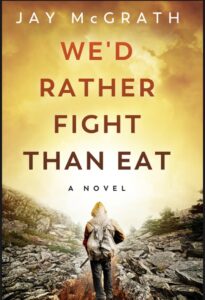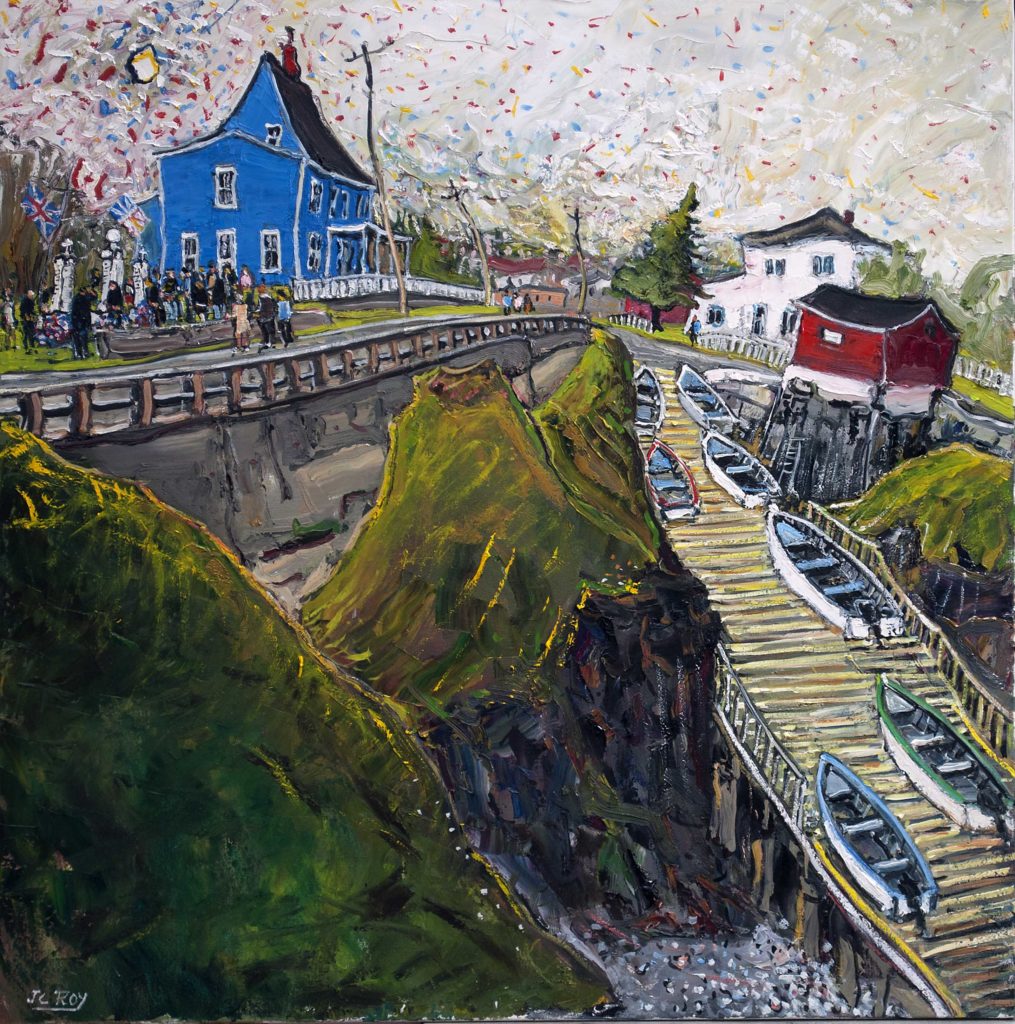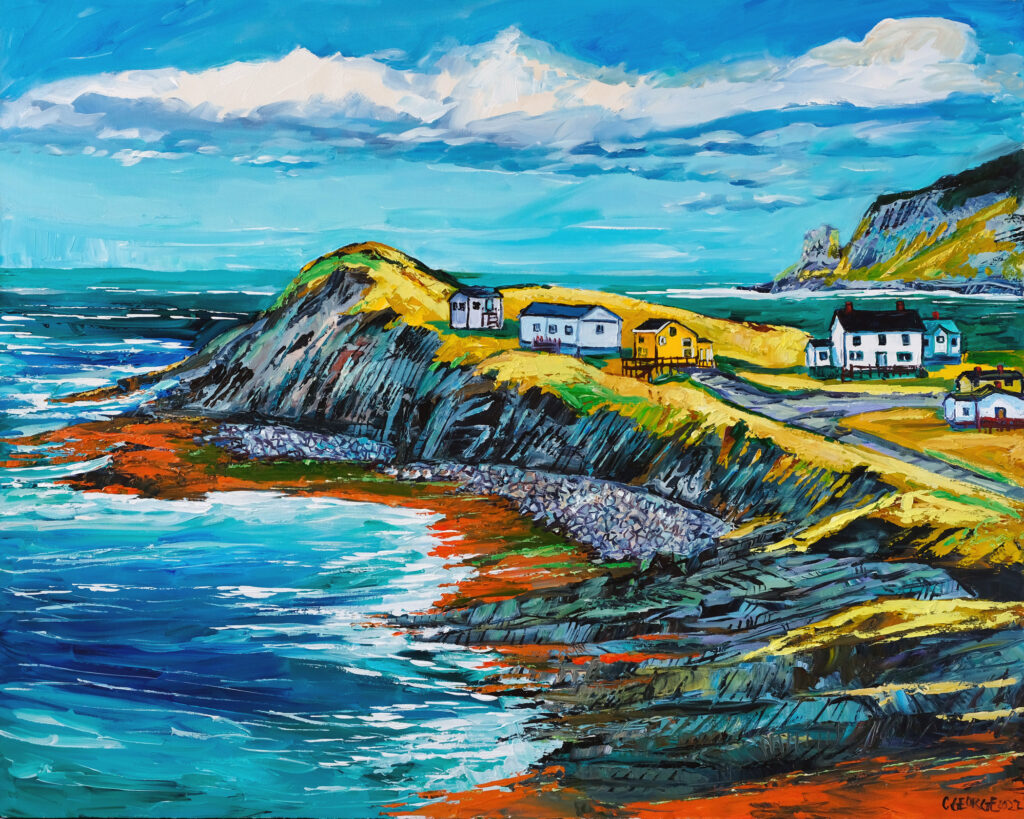Jay McGrath & the end of the world as he knows it: “It hit me – what if something bad happened? Like really bad. What would we do?”
October 2023
Can you tell us a little about yourself?
I grew up in Branch, which is a community about 90 minutes outside St John’s. I did a bunch of stuff at Memorial University. I have a two undergrads – Business and Arts (which I have a double major in English and History) and a Master of Arts in History, I focused on NL History. I wrote my major research paper about Fogo Island in 1967 despite having never been to Fogo Island (I know, I really need to get there). And I studied Creative Writing at Memorial too. See, I started down the road of writing a book and quickly realized I was in over my head, so the creative writing courses helped me tremendously.
I also have a day job I enjoy, which is in human resources for the public sector. Half a dozen kids call me Uncle Jay, none of them are biologically my nieces and nephews, but the level of love is no less than if they were. I dedicated the book to them in hopes someday they too will pursue their dreams. I’m so proud of them and I hope they’re proud of me. If you’re wondering how important dedicating the book to them was for me – well, I fought off some emotion just telling you this. Other than that, I have two dogs (Pug/Boston Terrier mixes) who supervised most of the writing for this book, you’ll often find me on a trail with them. And I can be pretty particular about things. Let me give you an example – coffee. I grind the beans most mornings, use a pour over, and drink it black out of a quirky mug.
How did you get the idea for We’d Rather Fight Than Eat?
Way back, like pre-pandemic back, our communication systems randomly went down for a while. We found out later there was some damage to a fibre optic cable. At the time, we just knew our cell phones and our debit/card cards weren’t working. A bunch of systems were down. The following Sunday, I went to the Garden Party in Branch, which if you haven’t been you need to go, and I was stood in the middle of the Garden Party grounds chatting with a friend, and it hit me – what if something bad happened? Like really bad. What would we do? And I thought about the people stood around me, some of them live in Branch, some of them used to live in Branch and some of them are just passing through. It is a real mixture of people. How would we respond and the first thing I could think of was well, we’d cut off the roads into the community and cut down a bunch of trees on the outskirts so we could see if anyone was coming. I loved that image of hundreds and hundreds of tree stumps on the outskirts of the community.
But having a scenario is just a part of it. I also had a character, Jack, who I thought would be the right lens to apply on the story. Someone who finds himself in the middle of everything. He is in the middle of his two best friends, two love interests, two sides of the community, oh and he has a heap of anxieties. So, when you have a character and a scenario, you put them together and see what happens.
I wanted to explore a story layered in conflict. There’s the conflict within the community of Beckford, a conflict with the neighbouring community and, of course, the conflict that arrives on their doorstep from St John’s.

Where are we when the book opens?
The book opens in Beckford some time after society has collapsed. Enough time has passed where these people have worked out some kinks, they’ve inventoried the medicine, they’ve worked on the school curriculum. But there’s been some struggle too and there’s been some discussion about exploring other options. What else is out there? Can they partner up with their neighbouring community of Gull Cove?
And we open with Jack and Sarah, just hanging out at Jack’s house, when (not their uncle but everyone’s) Uncle Stevie bursts in telling them that for the first time in months, for the first time since Jack’s wife, who isn’t Sarah, arrived in Beckford, ‘Someone’s coming.’ Drama ensues from there.
Can you tell us a little about the main characters, and are they inspired by real people?
The stories I enjoy most feature an ensemble cast of characters. I wanted to create a bunch of strong characters and clash them against each other in interesting ways.
Jack is our main lens with which we see the story unfold, he’s an anxious guy. Someone who on a good day liked to have some Ativan in his pocket – just in case. He loves his wife but he’s in love with his friend. He struggles to pick a side in most situations, to make a decision, and in this story, he has to choose.
Everyone so far loves Ryan. He’s Jack’s running mate, he’s been friends with Jack since childhood, Jack was Ryan’s first friend but I don’t think the reverse is true. In Ryan’s mind, he owes Jack his life and he’d probably die for Jack, which, you can decide how good of a thing that really is. Ryan is the kind of guy who will use salmon tags to tie someone’s hands behind their back in a shed, which he does of course. And he’s also gathering a collection of crosses on a hilltop.
Most people so far also love Megan. She’s the teacher, she’s a member of the all-female Community Council in Beckford, she’s the lynchpin of the community. Megan’s husband is cheating on her with a former student, her mother-in-law is the mayor and her deceased mother made Megan promise to always look out for her older brother.
And of course, Danielle. She’s the ‘big bad’ coming after the person who lands on Beckford’s doorstep in our opening chapter. She used to be a successful businessperson, she’s the type who is always playing chess, never checkers. There’s a nice collection of music in her downtown office, a few art pieces too, and tattoo equipment for good measure. She’ll absolutely burn Beckford to the ground if she has to.
With this said, I put a fair chunk of myself in these characters. There’s a lot of my anxiety in Jack, some of my humor is in Ryan, but only some, and some of my story is in Megan. All characters are purely fictional and any resemblance to any person real or fictional, alive or deceased, is purely coincidental. I think I’m legally obligated to say this. Although one of my friends swears he is Ryan.
What about the title?
The title is special for me. While its an expression I grew up with in Branch, it is an expression I associate most with my grandfather. He loved telling stories too, all of them true of course, even the ones he completely made up. You know how many stories I heard under the thick heat of a woodstove? A lot. If there was something going on in the community, a bit of mischief or aggression, he would often say ‘This crowd? We’d rather fight than eat.’ So, to have this title makes me feel like he is part of this process with me.
Interestingly, since the book came out, a number of people, from all over, have told me they grew up with this expression too. I owe a thank you to Flanker Press on this one as I had another title in mind. Jerry came back and said ‘Are there any other options?’ I pitched a few and he said ‘That’s the one.’ I’m really glad we did this and it made me realize early on in the publishing process to lean on the experts.
How do you, or can you, “research” something like this? I was struck, for example, by the community taking inventory of firearms and medicine. It seemed very sensible. Is there some kind of “to do list” to follow in case of such an emergency?
I’m delighted it seemed sensible. I mentioned before I enjoy stories with an ensemble of characters, however, I also enjoy stories about people in isolation. So, I’ve absorbed many of those types of stories which I’ll argue is a type of research. Stephen King’s The Stand is an influence, for example, and even one of my characters, Abigail, is an homage to his story, although my Abigail is the polar opposite of his.
I put a lot of thought into it, just thinking logically – what would we do? Well, we’d block off the road and we’d put people in charge of certain things. If the situation worsened we’d decide on the best vehicles to use but only if we needed to and we’d conserve our gas. But I also considered, as time wore on, what would we became complacent about? We’d planned to put a foghorn at the lookout post but as the weeks go by and there’s nobody coming, we didn’t bother with the foghorn. Then the batteries didn’t get replaced in the radios either. There’s a lot of thought and details I have about the situation in Beckford that’ll never be printed. And that’s fine, you probably don’t need to know how many people are growing potatoes in their garden.
Can you share a few teasers for the sequel? When will it be published?
Well, there is more Beckford story to tell. Anyone who has read the book probably has an idea of where we’re heading next. Book Two is drafted, there’s still a lot of editing needed but we’ll get there. Flanker tells me we’re looking at a Fall 2024 release, which I’m quite comfortable with. With that said, supporting local authors is really important, so if anyone enjoyed the book, I’d encourage them to share it on social media, leave a review, tell a friend. Everything helps to get us to Book Two and beyond.
As for teasers – well, how about a spoiler? There’s only one character truly safe until the end – Bella, the German Shepard. I’m not strong enough to kill the dog.
We’d Rather Fight Than Eat is available from Flanker Press.



